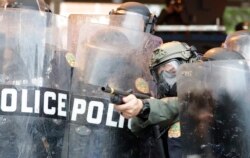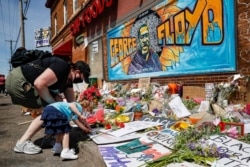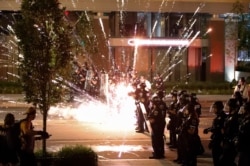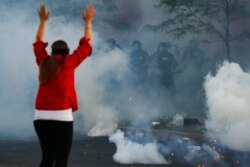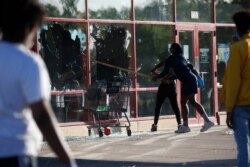Fires, looting and chaos erupted in dozens of American cities Saturday night as demonstrators clashed with police in protests sparked by the death last week of an African American man while in police custody in the midwestern city of Minneapolis.
Police cars and government buildings were set afire. Windows of stores were smashed, while looters escaped with high-priced consumer goods. Monuments in parks were spray painted and vandalized.
Police and authorities in riot gear often stood guard with restraint as boisterous but largely peaceful street demonstrations swelled in size throughout Saturday. But as some of the protests turned violent as night fell, the authorities fired pepper pellets, tear gas and rubber bullets at demonstrators.
Many of the protesters ignored early evening curfews imposed by mayors in dozens of cities to march in the streets and clash with police. But protesters in some cities were peacefully hemmed in by police who arrested them one by one for the curfew violations.
Authorities in recent days, including President Donald Trump, said they understood the rage over the death of George Floyd, but called for peaceful protests and condemned violence, vowing that it would be met with force. Floyd, a 46-year-old black man, was held handcuffed while face down on a Minneapolis street, repeatedly saying he could not breathe as a white police officer pressed a knee on his neck. Floyd died, and the police officer was charged with third degree murder several days later. The cellphone images of Floyd’s death have sparked global outrage, with protests spreading across the country.
The growing protests have now extended for five days, possibly the biggest coast to coast demonstrations in the U.S. since the extended anti-Vietnam war protests of the 1960s.
The governors of Minnesota, where St. Paul, an adjoining city of Minneapolis, is the capital, and 14 other states called up National Guard troops to face another night of violent protests.
In all, about 5,000 National Guard soldiers and airmen were activated across the country, with another 2,000 prepared to activate if needed.
For the past five nights, initially peaceful protesting has degenerated into looting, arson and other violence in Minneapolis and St. Paul, as well as other cities across the U.S.
“We are under assault,” first-term Minnesota Governor Tim Walz said as he promised “full strength” would be used to restore order.
In New York City, the police commissioner said nearly 350 people were arrested during protests Saturday night. More than 30 officers sustained minor injuries and there was some property damage and burning of police vehicles.
More protests are expected Sunday, but Mayor Bill de Blasio said he has no plans to impose a curfew on the city of 8.6 million, which is still fighting the coronavirus pandemic.
He said most of the protesters have been peaceful. He attributed the pockets of violence to what he described as a small, well-organized group of people, some associated with anarchist movements, who coordinated online. Some people live locally, while others came from outside the area.
“What we do know, is there is an explicit agenda of violence and it does not conform with the history of this city in which we have always honored non-violent protest,” de Blasio said.
California Governor Gavin Newsom declared a state of emergency for Los Angeles, where protesters were in the street late Saturday as fires burned.
In downtown Indianapolis, there were multiple shootings Saturday during a second night of protests. One person was killed and two people were wounded. Police Chief Randal Taylor urged residents who did not live in the area to leave because, he said, “Downtown is not safe at this time.”
Nearly 1,400 people have been arrested across the country, according to an Associated Press tally Saturday. The actual total is probably higher as the protests continued through the night.
Mayors across the U.S. have instituted nighttime curfews after violence occurred in their cities, including Los Angeles; Seattle; Atlanta; Denver; Philadelphia; Portland, Oregon; and Columbia, South Carolina.
While some protests have led to violence — including arson and looting in Minneapolis and Portland — others have remained peaceful, as in Wilmington, Delaware, and Greenville, South Carolina.
Protests near the White House in Washington erupted into violence late Saturday. Some protesters set off fireworks and threw bottles at the Secret Service and the U.S. Park Police, who used pepper spray. Later, hundreds of protesters circled the White House and looted nearby stores as a fire erupted near the historic Hay Adams Hotel.
President Trump spoke about the unrest Saturday afternoon at the Kennedy Space Center, where he watched the SpaceX launch.
“The death of George Floyd on the streets of Minneapolis, was a grave tragedy. It should never have happened. It has filled Americans all over the country with horror, anger and grief,” he said.
“I stand before you as a friend and ally to every American seeking justice and peace. And I stand before you in firm opposition to anyone exploiting this tragedy to loot, rob, attack, and menace. Healing not hatred, justice not chaos, are the mission at hand,” he said.
But he added that Minneapolis cannot let chaos rule as it did early Friday when officers abandoned a police station and ignored protesters for several hours. Police eventually used tear gas to disperse the crowds.
The president has blamed most of the violence on “Antifa and other radical left-wing groups,” and offered Minnesota federal military assistance.
Attorney General William Barr said in a statement, “The outrage of our national community about what happened to George Floyd in Minneapolis is real and legitimate."
“Accountability for his death must be addressed,” he continued, “and is being addressed, through the regular process of our criminal justice system, both at the state and at the federal level. That system is working and moving at exceptional speed. Already initial charges have been filed. That process continues to move forward. Justice will be served.”
Minnesota Governor Walz said organized agitators from outside the state were responsible for some of the violence, including white supremacists, anarchists and people associated with drug cartels.
Numerous Minneapolis businesses suffered extensive property damage as protesters randomly looted stores in a Minneapolis neighborhood near the site where Floyd died. Somali-American business owner Ahmed Siyad Shafi’i told VOA that vandals attacked all his of his stores overnight.
“They broke the glass, the doors, the windows,” he said via Skype, “and take whatever they can take.” Shafi’i, the owner of a restaurant and clothing store in South Minneapolis, called it “unacceptable” for anyone to destroy personal property and suggested peaceful protests.
The full mobilization of the Minnesota National Guard increases its presence beyond the 700 soldiers previously deployed. Major General Jon Jensen said there would be more than 1,700 National Guard in the area by Sunday.
The National Guard is a reserve military force with units in each of the 50 states, most of whose members serve part-time. The units can be activated in emergencies by the state governors to help deal with natural disasters or civil unrest.
Derek Chauvin, the officer seen restraining Floyd in the video, was fired on Tuesday from the Minneapolis Police Department. He was charged Friday with third-degree murder and second-degree manslaughter. Bail was set at $500,000.
VOA's correspondent Margaret Besheer and VOA Somali Service contributed to this report.





